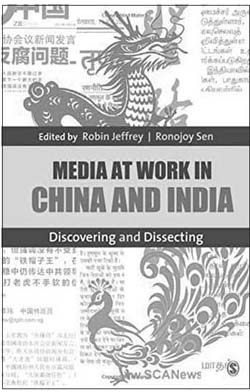This volume offers a comparative perspective of media in two very different countries, and the ways in which they are changing. Eighteen writers—mostly scholars and journalists—bring their experience and differing perspectives to it, and pick a range of subjects to look at, through twin perspectives. The editors devise a structure in which chapters on China and India alternate through four sections which explore structure, reporters, practices and comparative case studies in two areas—social media, and disaster reporting. The product of a six-year process anchored at the National University of Singapore, it is a multi-faceted volume on comparative media systems, with so many different sub topics and approaches that it becomes difficult to encapsulate what it offers in the space of a review.
An introduction on the four sames and three differents in the two media systems sets the stage. The sames are advertising (a surprise there), the vast number of media outlets, the experience of journalists in the newsrooms and the degree of suspicion and hostility with which media in the two countries regard the other country. The differences are language (one common written language in China and much higher literacy), the degree of control and regulation, and the self perception of their role by the media in the two countries. The Chinese thought it was their job to promote development and harmony, the Indians thought their role was to keep politicians honest.
Li Yang’s opening chapter on the evolution of Chinese media is fascinating for an Indian reader—it is a lucid account of the country’s historical evolution and media’s ordained place in the scheme of things. Since India is not a country where nationwide debates are held on the criterion for truth, or where periodic decisions are taken by the state leadership on what role the media should play in society (a tool of class struggle, then a tool of public opinion, and so on) this chapter is an education in how a ‘directed’ media system evolves. The media in China became part of the market because in 1978 the government picked eight major state-owned enterprises to experiment with ‘running as enterprises’. It is now a booming sunrise industry.
On the Indian side you have Robin Jeffrey revisiting his scholarship on the subject to describe the business and ownership of newspapers in India, as well as the people who become journalists.
Television is dealt with in a variety of chapters from different perspectives—those of the media business, and that of journalism. Ying Jhu, a scholar who has written extensively on China Central Television looks at China’s culture war against the West, its political economy, and the political, ideological and market reasons which drive it. She discusses bans of entertainment shows both western and Chinese, the reasons are to do not just with political control, but also profit share. When a provincial broadcaster launches a talent show which becomes an overnight sensation, CCTV goes into attack mode to ward off the ratings competition! Given the highly unequal competition between our state broadcaster and regional TV channels nothing of the sort could happen here.

